初英考点精讲 同课异构 120 请求求助看病【知识点微课课件】
文档属性
| 名称 | 初英考点精讲 同课异构 120 请求求助看病【知识点微课课件】 |  | |
| 格式 | ppt | ||
| 文件大小 | 563.5KB | ||
| 资源类型 | 试卷 | ||
| 版本资源 | 通用版 | ||
| 科目 | 英语 | ||
| 更新时间 | 2021-07-15 11:33:23 | ||
图片预览


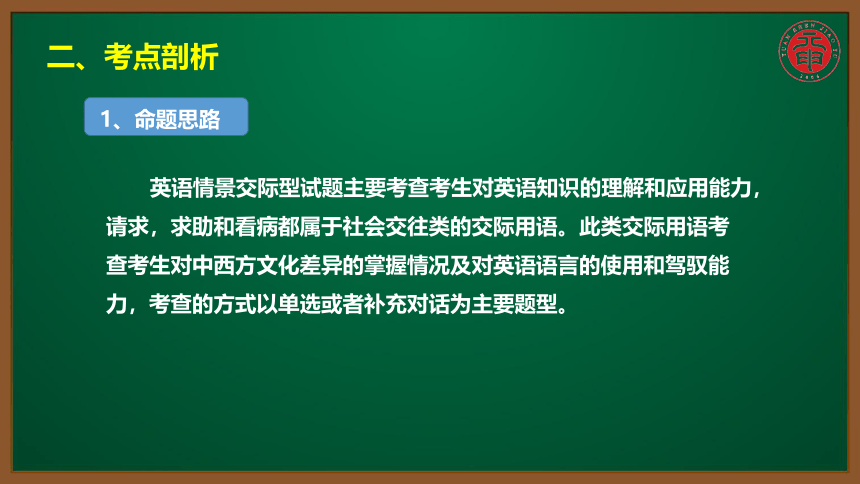
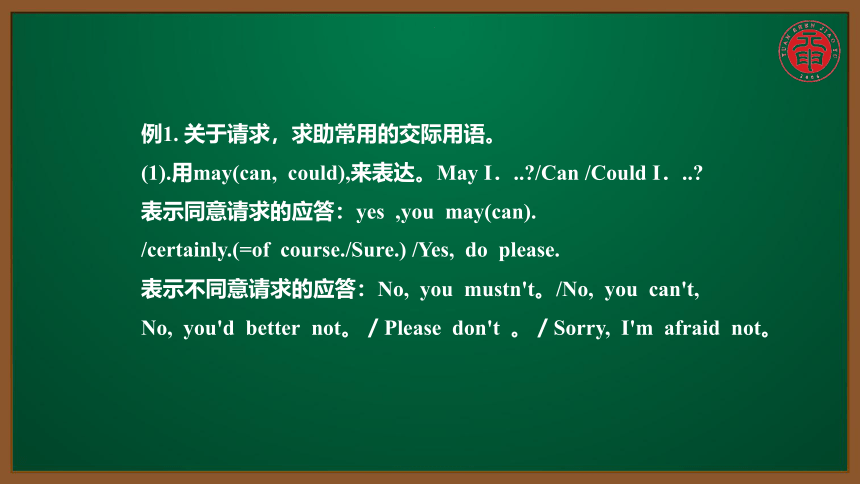
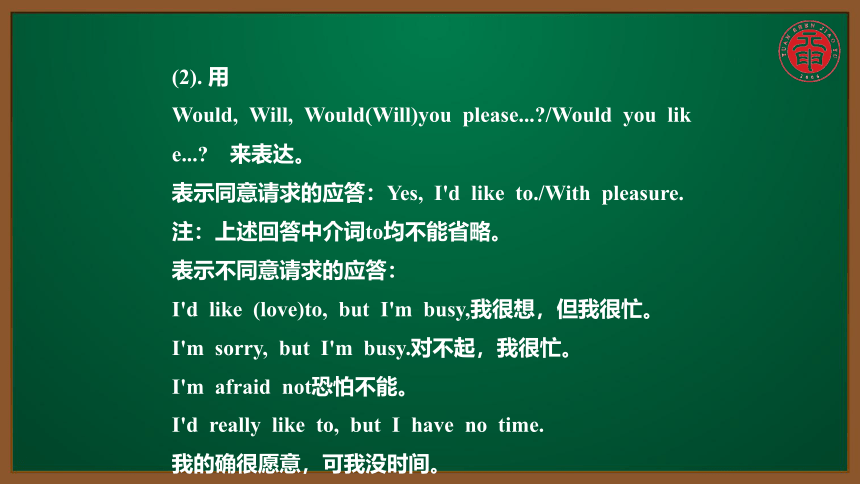
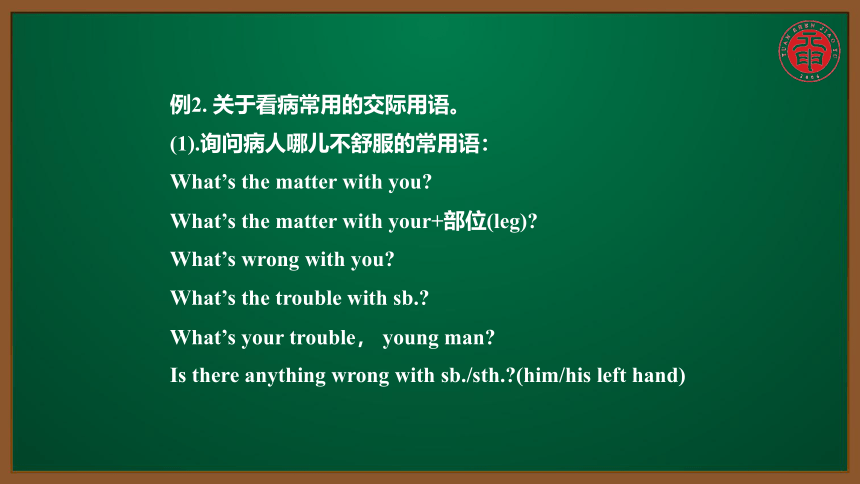
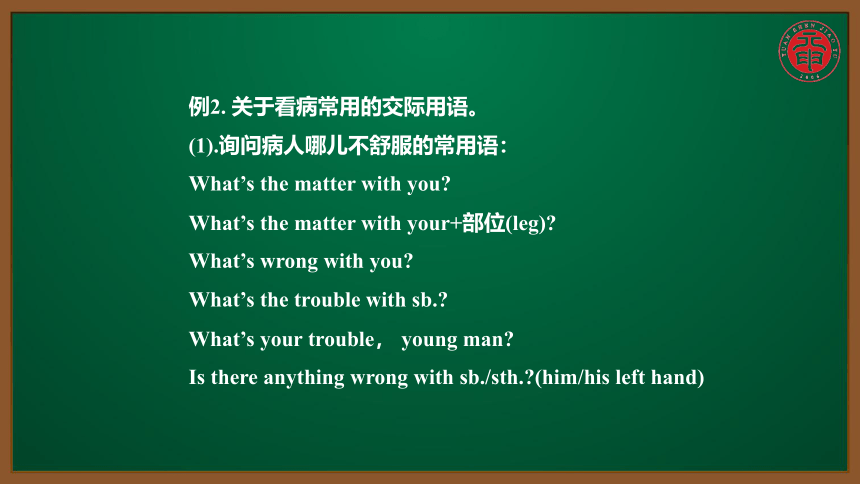
文档简介
请 求 求 助 看 病
—What's the matter?你怎么了?
—I have a sore throat.我喉咙痛。
—I have got a headache/cough. 我头痛/ 咳嗽。
—I'm not feeling well./I don't feel very well./I feel terrible.
我感觉不舒服。
一、激趣导入
同学们,请下列句子,理解情景对话中句子表达的意思。
本课我们一起来学习英语中关于请求,求助和看病的情景交际用法。
二、考点剖析
1、命题思路
英语情景交际型试题主要考查考生对英语知识的理解和应用能力,请求,求助和看病都属于社会交往类的交际用语。此类交际用语考查考生对中西方文化差异的掌握情况及对英语语言的使用和驾驭能力,考查的方式以单选或者补充对话为主要题型。
例1. 关于请求,求助常用的交际用语。
(1).用may(can,?could),来表达。?
表示同意请求的应答:yes?,you?may(can). /certainly.(=of?course./Sure.)
Yes,?do?please.
表示不同意请求的应答:No,?you?mustn't。/No,?you?can't, No,?you'd?better?not。/Please?don't?。/Sorry,?I'm?afraid?not。? 3、用Would,?Will,?Would(Will)you?please...?/Would?you?like...???来表达。? ?表示同意请求的应答:Yes,?I'd?like?to.(=Yes,?I'd?love?to.=Yes,?I'll?be?glad?to.=Yes,?I?should?I?like?to)是的,我愿意。/With?pleasure.十分愿意。?注:上述回答中介词to均不能省略。? 表示不同意请求的应答:I'd?like?(love)to,?but?I'm?busy,我很想,但我很忙。/I'm?sorry,?but?I'm?busy.对不起,我很忙。/I'm?afraid?not恐怕不能。/I'd?really?like?to,?but?I?have?no?time.我的确很愿意,可我没时间。?4、用please?来表达。?表示同意请求的应答:OK,(=All?right.)好的。/of?course.(=Sure.=Certainly.)当然可以。/With?pleasure.十分愿意。? 表示不同意请求的应答:I'm?sorry,?but?I'm?busy,对不起,我很忙,/I'm?afraid?not?恐怕不行。
(2). 用Would,?Will,?Would(Will)you?please...?/Would?you?like...???来表达。? ?
表示同意请求的应答:Yes,?I'd?like?to./With?pleasure.
注:上述回答中介词to均不能省略。?
表示不同意请求的应答:
I'd?like?(love)to,?but?I'm?busy,我很想,但我很忙。
/I'm?sorry,?but?I'm?busy.对不起,我很忙。/
I'm?afraid?not恐怕不能。/
I'd?really?like?to,?but?I?have?no?time.
我的确很愿意,可我没时间。
例2. 关于看病常用的交际用语。
(1).询问病人哪儿不舒服的常用语:
What’s the matter with you?
What’s the matter with your+部位(leg)?
What’s wrong with you?
What’s the trouble with sb.?
What’s your trouble, young man?
Is there anything wrong with sb./sth.?(him/his left hand)
例2. 关于看病常用的交际用语。
(1).询问病人哪儿不舒服的常用语:
What’s the matter with you?
What’s the matter with your+部位(leg)?
What’s wrong with you?
What’s the trouble with sb.?
What’s your trouble, young man?
Is there anything wrong with sb./sth.?(him/his left hand)
(2).病人谈论病情通常为:
I don’t feel well.
I have a (bad) headache.
I have got a (bad)cough.
I have got a bad cold./I have (got)a fever./I have got a pain here.
There is something wrong with my eyes.
I’m not very well./I don’t feel very well/I’m not feeling very well.
I feel terrible(bad/ill).
I feel tired all the time./I feel very weak.
(3). 医生安慰病人的常用语:
It’s nothing serious./Nothing serious.
You’ll be well (fine/OK)again in a few days.
You’ll be all right soon.
Don’t worry, you’ll be well soon.
1. —What's the matter with Tina?—________.
A.She is away B.She has a bad cold C.She should take some medicine
2.—?Could?you?answer?this?question,?please?—_______.??
A.?I?could?B.?Yes,?I?couldn’t?C.?Never?mind??D.?Well,?let?me?try
3.—Would?you?help?me?clean?up?the?classroom,?Bill??????????????????????—____________.?
A.?Yes,?quite?right???????????????B.?Never?mind?
C.?That’s?all?right???????????????D.?Sure,?with?pleasure
练习一、单项选择,请选出正确的答案.
2、练一练
B
D
D
4—?Excuse?me,?could?I?take?this?seat??—?Sorry,______.? ???????
A.?here?you?are?B.?take?it?C.?it's?taken?D.?never?mind?
5. —_______?? ?
? —I?have?a?headache?and?I?don’t?feel?like?eating?anything.????
A.?How?are?you???????B.?What?can?I?do?for?you????
C.?What’s?the?matter?with?you????D.?How?do?you?like?I
6. —Can?I?park?my?car?here,?sir?????
—__________.?You?see,?there’s?much?traffic?here.? ?
A.?Never?mind?? B.?You’d?better?not??
C.?Of?course?not? D.?Yes,?please
A
A
B
Tom:?Hi,?Amy.?
Amy:?Hi,?Tom.??1 ???What’s?wrong?with?you??
Tom:?I?have?a?stomach?ache.?
Amy:?What?did?you?eat?for?lunch??
Tom:??2 ??.
Amy:?I?see.?Maybe?it?is?caused?by?them.?
Tom:??3 ? ? .
Amy:?Do?you?often?just?have?snacks?for?lunch??
Tom:?Yes,?very?often.?
Amy:?Oh!?? 4???Snacks?are?bad?for?health.?
Tom:?I?know?that.??5 ???But?I?really?enjoy?them.
Amy:?Anyway,?you?should?try?to?eat?less.?
Tom:?You’re?right.?I’ll?try.? ??????????????
正确答案:?G A E F D
练习三、从方框内选择恰当的句子完成下面对话。
A. I?ate?nothing?but?some?snacks.?
B. I?hope?so.?
C.?You?look?happy.?
D.?And?my?parents?often?tell?me?not?to?eat?them.?
E. I?guess?so.?
F.?That’s?not?a?good?habit.?
G.?You?don’t?look?well.? ? ?
3、答题技巧
情景交际总是围绕谈话的中心内容来展开对话的,所以,通读对话抓住谈话的人物身份、时间、地点和核心内容是顺利完成此类题目的前提。
2. 同样一句话,因使用的时间、场合、身份不同而有不同的含义和不同的表达方式,因此要依据上下文的句法关系寻找答案。
3. 熟练掌握关于请求求助以及看病常用的日常交际用语。
4. 注意在情景对话中使用的英美人的习惯用语。
三、思维导图
例1. 关于请求,求助常用的交际用语。
(1).用may(can,?could),来表达。?
表示同意请求的应答:yes?,you?may(can). /certainly.(=of?course./Sure.) /Yes,?do?please.
表示不同意请求的应答:No,?you?mustn't。/No,?you?can't, No,?you'd?better?not。/Please?don't?。/Sorry,?I'm?afraid?not。?
例1. 关于请求,求助常用的交际用语。
(1).用may(can,?could),来表达。May I...?/Can /Could I...??
表示同意请求的应答:yes?,you?may(can). /certainly.(=of?course./Sure.) /Yes,?do?please.
表示不同意请求的应答:No,?you?mustn't。/No,?you?can't, No,?you'd?better?not。/Please?don't?。/Sorry,?I'm?afraid?not。?
(2). 用Would,?Will,?Would(Will)you?please...?/Would?you?like...???来表达。? ?
表示同意请求的应答:Yes,?I'd?like?to./With?pleasure.
注:上述回答中介词to均不能省略。?
表示不同意请求的应答:
I'd?like?(love)to,?but?I'm?busy,我很想,但我很忙。
I'm?sorry,?but?I'm?busy.对不起,我很忙。
I'm?afraid?not恐怕不能。
I'd?really?like?to,?but?I?have?no?time.
我的确很愿意,可我没时间。
1. —What's the matter with Tina?—________.
A.She is away B.She has a bad cold C.She should take some medicine
2.—?Could?you?answer?this?question,?please?—_______.??
A.?I?could?B.?Yes,?I?couldn’t?C.?Never?mind??D.?Well,?let?me?try
3.—Would?you?help?me?clean?up?the?classroom,?Bill??????????????????????—____________.?
A.?Yes,?quite?right???????????????B.?Never?mind?
C.?That’s?all?right???????????????D.?Sure,?with?pleasure
练习一、单项选择,请选出正确的答案.
2、练一练
B
D
D
三、思维导图
二、考点剖析
1、命题思路
英语情景交际型试题主要考查考生对英语知识的理解和应用能力,请求,求助和看病都属于社会交往类的交际用语。此类交际用语考查考生对中西方文化差异的掌握情况及对英语语言的使用和驾驭能力,考查的方式以单选或者补充对话为主要题型。
4—?Excuse?me,?could?I?take?this?seat??—?Sorry,______.? ???????
A.?here?you?are?B.?take?it?C.?it's?taken?D.?never?mind?
5. —_______?? ?
? —I?have?a?headache?and?I?don’t?feel?like?eating?anything.????
A.?How?are?you???????B.?What?can?I?do?for?you????
C.?What’s?the?matter?with?you????D.?How?do?you?like?I
6. —Can?I?park?my?car?here,?sir?????
—__________.?You?see,?there’s?much?traffic?here.? ?
A.?Never?mind?? B.?You’d?better?not??
C.?Of?course?not? D.?Yes,?please
A
A
B
3、答题技巧
情景交际总是围绕谈话的中心内容来展开对话的,所以,通读对话抓住谈话的人物身份、时间、地点和核心内容是顺利完成此类题目的前提。
2. 同样一句话,因使用的时间、场合、身份不同而有不同的含义和不同的表达方式,因此要依据上下文的句法关系寻找答案。
3. 熟练掌握关于请求求助以及看病常用的日常交际用语。
4. 注意在情景对话中使用的英美人的习惯用语。
—What's the matter?你怎么了?
—I have a sore throat.我喉咙痛。
—I have got a headache/cough. 我头痛/ 咳嗽。
—I'm not feeling well./I don't feel very well./I feel terrible.
我感觉不舒服。
一、激趣导入
同学们,请下列句子,理解情景对话中句子表达的意思。
本课我们一起来学习英语中关于请求,求助和看病的情景交际用法。
二、考点剖析
1、命题思路
英语情景交际型试题主要考查考生对英语知识的理解和应用能力,请求,求助和看病都属于社会交往类的交际用语。此类交际用语考查考生对中西方文化差异的掌握情况及对英语语言的使用和驾驭能力,考查的方式以单选或者补充对话为主要题型。
例1. 关于请求,求助常用的交际用语。
(1).用may(can,?could),来表达。?
表示同意请求的应答:yes?,you?may(can). /certainly.(=of?course./Sure.)
Yes,?do?please.
表示不同意请求的应答:No,?you?mustn't。/No,?you?can't, No,?you'd?better?not。/Please?don't?。/Sorry,?I'm?afraid?not。? 3、用Would,?Will,?Would(Will)you?please...?/Would?you?like...???来表达。? ?表示同意请求的应答:Yes,?I'd?like?to.(=Yes,?I'd?love?to.=Yes,?I'll?be?glad?to.=Yes,?I?should?I?like?to)是的,我愿意。/With?pleasure.十分愿意。?注:上述回答中介词to均不能省略。? 表示不同意请求的应答:I'd?like?(love)to,?but?I'm?busy,我很想,但我很忙。/I'm?sorry,?but?I'm?busy.对不起,我很忙。/I'm?afraid?not恐怕不能。/I'd?really?like?to,?but?I?have?no?time.我的确很愿意,可我没时间。?4、用please?来表达。?表示同意请求的应答:OK,(=All?right.)好的。/of?course.(=Sure.=Certainly.)当然可以。/With?pleasure.十分愿意。? 表示不同意请求的应答:I'm?sorry,?but?I'm?busy,对不起,我很忙,/I'm?afraid?not?恐怕不行。
(2). 用Would,?Will,?Would(Will)you?please...?/Would?you?like...???来表达。? ?
表示同意请求的应答:Yes,?I'd?like?to./With?pleasure.
注:上述回答中介词to均不能省略。?
表示不同意请求的应答:
I'd?like?(love)to,?but?I'm?busy,我很想,但我很忙。
/I'm?sorry,?but?I'm?busy.对不起,我很忙。/
I'm?afraid?not恐怕不能。/
I'd?really?like?to,?but?I?have?no?time.
我的确很愿意,可我没时间。
例2. 关于看病常用的交际用语。
(1).询问病人哪儿不舒服的常用语:
What’s the matter with you?
What’s the matter with your+部位(leg)?
What’s wrong with you?
What’s the trouble with sb.?
What’s your trouble, young man?
Is there anything wrong with sb./sth.?(him/his left hand)
例2. 关于看病常用的交际用语。
(1).询问病人哪儿不舒服的常用语:
What’s the matter with you?
What’s the matter with your+部位(leg)?
What’s wrong with you?
What’s the trouble with sb.?
What’s your trouble, young man?
Is there anything wrong with sb./sth.?(him/his left hand)
(2).病人谈论病情通常为:
I don’t feel well.
I have a (bad) headache.
I have got a (bad)cough.
I have got a bad cold./I have (got)a fever./I have got a pain here.
There is something wrong with my eyes.
I’m not very well./I don’t feel very well/I’m not feeling very well.
I feel terrible(bad/ill).
I feel tired all the time./I feel very weak.
(3). 医生安慰病人的常用语:
It’s nothing serious./Nothing serious.
You’ll be well (fine/OK)again in a few days.
You’ll be all right soon.
Don’t worry, you’ll be well soon.
1. —What's the matter with Tina?—________.
A.She is away B.She has a bad cold C.She should take some medicine
2.—?Could?you?answer?this?question,?please?—_______.??
A.?I?could?B.?Yes,?I?couldn’t?C.?Never?mind??D.?Well,?let?me?try
3.—Would?you?help?me?clean?up?the?classroom,?Bill??????????????????????—____________.?
A.?Yes,?quite?right???????????????B.?Never?mind?
C.?That’s?all?right???????????????D.?Sure,?with?pleasure
练习一、单项选择,请选出正确的答案.
2、练一练
B
D
D
4—?Excuse?me,?could?I?take?this?seat??—?Sorry,______.? ???????
A.?here?you?are?B.?take?it?C.?it's?taken?D.?never?mind?
5. —_______?? ?
? —I?have?a?headache?and?I?don’t?feel?like?eating?anything.????
A.?How?are?you???????B.?What?can?I?do?for?you????
C.?What’s?the?matter?with?you????D.?How?do?you?like?I
6. —Can?I?park?my?car?here,?sir?????
—__________.?You?see,?there’s?much?traffic?here.? ?
A.?Never?mind?? B.?You’d?better?not??
C.?Of?course?not? D.?Yes,?please
A
A
B
Tom:?Hi,?Amy.?
Amy:?Hi,?Tom.??1 ???What’s?wrong?with?you??
Tom:?I?have?a?stomach?ache.?
Amy:?What?did?you?eat?for?lunch??
Tom:??2 ??.
Amy:?I?see.?Maybe?it?is?caused?by?them.?
Tom:??3 ? ? .
Amy:?Do?you?often?just?have?snacks?for?lunch??
Tom:?Yes,?very?often.?
Amy:?Oh!?? 4???Snacks?are?bad?for?health.?
Tom:?I?know?that.??5 ???But?I?really?enjoy?them.
Amy:?Anyway,?you?should?try?to?eat?less.?
Tom:?You’re?right.?I’ll?try.? ??????????????
正确答案:?G A E F D
练习三、从方框内选择恰当的句子完成下面对话。
A. I?ate?nothing?but?some?snacks.?
B. I?hope?so.?
C.?You?look?happy.?
D.?And?my?parents?often?tell?me?not?to?eat?them.?
E. I?guess?so.?
F.?That’s?not?a?good?habit.?
G.?You?don’t?look?well.? ? ?
3、答题技巧
情景交际总是围绕谈话的中心内容来展开对话的,所以,通读对话抓住谈话的人物身份、时间、地点和核心内容是顺利完成此类题目的前提。
2. 同样一句话,因使用的时间、场合、身份不同而有不同的含义和不同的表达方式,因此要依据上下文的句法关系寻找答案。
3. 熟练掌握关于请求求助以及看病常用的日常交际用语。
4. 注意在情景对话中使用的英美人的习惯用语。
三、思维导图
例1. 关于请求,求助常用的交际用语。
(1).用may(can,?could),来表达。?
表示同意请求的应答:yes?,you?may(can). /certainly.(=of?course./Sure.) /Yes,?do?please.
表示不同意请求的应答:No,?you?mustn't。/No,?you?can't, No,?you'd?better?not。/Please?don't?。/Sorry,?I'm?afraid?not。?
例1. 关于请求,求助常用的交际用语。
(1).用may(can,?could),来表达。May I...?/Can /Could I...??
表示同意请求的应答:yes?,you?may(can). /certainly.(=of?course./Sure.) /Yes,?do?please.
表示不同意请求的应答:No,?you?mustn't。/No,?you?can't, No,?you'd?better?not。/Please?don't?。/Sorry,?I'm?afraid?not。?
(2). 用Would,?Will,?Would(Will)you?please...?/Would?you?like...???来表达。? ?
表示同意请求的应答:Yes,?I'd?like?to./With?pleasure.
注:上述回答中介词to均不能省略。?
表示不同意请求的应答:
I'd?like?(love)to,?but?I'm?busy,我很想,但我很忙。
I'm?sorry,?but?I'm?busy.对不起,我很忙。
I'm?afraid?not恐怕不能。
I'd?really?like?to,?but?I?have?no?time.
我的确很愿意,可我没时间。
1. —What's the matter with Tina?—________.
A.She is away B.She has a bad cold C.She should take some medicine
2.—?Could?you?answer?this?question,?please?—_______.??
A.?I?could?B.?Yes,?I?couldn’t?C.?Never?mind??D.?Well,?let?me?try
3.—Would?you?help?me?clean?up?the?classroom,?Bill??????????????????????—____________.?
A.?Yes,?quite?right???????????????B.?Never?mind?
C.?That’s?all?right???????????????D.?Sure,?with?pleasure
练习一、单项选择,请选出正确的答案.
2、练一练
B
D
D
三、思维导图
二、考点剖析
1、命题思路
英语情景交际型试题主要考查考生对英语知识的理解和应用能力,请求,求助和看病都属于社会交往类的交际用语。此类交际用语考查考生对中西方文化差异的掌握情况及对英语语言的使用和驾驭能力,考查的方式以单选或者补充对话为主要题型。
4—?Excuse?me,?could?I?take?this?seat??—?Sorry,______.? ???????
A.?here?you?are?B.?take?it?C.?it's?taken?D.?never?mind?
5. —_______?? ?
? —I?have?a?headache?and?I?don’t?feel?like?eating?anything.????
A.?How?are?you???????B.?What?can?I?do?for?you????
C.?What’s?the?matter?with?you????D.?How?do?you?like?I
6. —Can?I?park?my?car?here,?sir?????
—__________.?You?see,?there’s?much?traffic?here.? ?
A.?Never?mind?? B.?You’d?better?not??
C.?Of?course?not? D.?Yes,?please
A
A
B
3、答题技巧
情景交际总是围绕谈话的中心内容来展开对话的,所以,通读对话抓住谈话的人物身份、时间、地点和核心内容是顺利完成此类题目的前提。
2. 同样一句话,因使用的时间、场合、身份不同而有不同的含义和不同的表达方式,因此要依据上下文的句法关系寻找答案。
3. 熟练掌握关于请求求助以及看病常用的日常交际用语。
4. 注意在情景对话中使用的英美人的习惯用语。
同课章节目录
- 词法
- 名词
- 动词和动词短语
- 动词语态
- 动词时态
- 助动词和情态动词
- 非谓语动词
- 冠词
- 代词
- 数词和量词
- 形容词副词及其比较等级
- 介词和介词短语
- 连词和感叹词
- 构词法
- 相似、相近词比较
- 句法
- 陈述句
- 一般疑问句和否定疑问句
- 特殊疑问句及选择疑问句
- 反意疑问句
- 存在句(There be句型)
- 宾语从句
- 定语从句
- 状语从句
- 主谓一致问题
- 简单句
- 并列句
- 复合句
- 主谓一致
- 主、表语从句
- 名词性从句
- 直接引语和间接引语
- 虚拟语气
- 感叹句
- 强调句
- 倒装句
- 祈使句
- 句子的成分
- 句子的分类
- 题型专区
- 单项选择部分
- 易错题
- 完形填空
- 阅读理解
- 词汇练习
- 听说训练
- 句型转换
- 补全对话
- 短文改错
- 翻译
- 书面表达
- 任务型阅读
- 语法填空
- 其他资料
